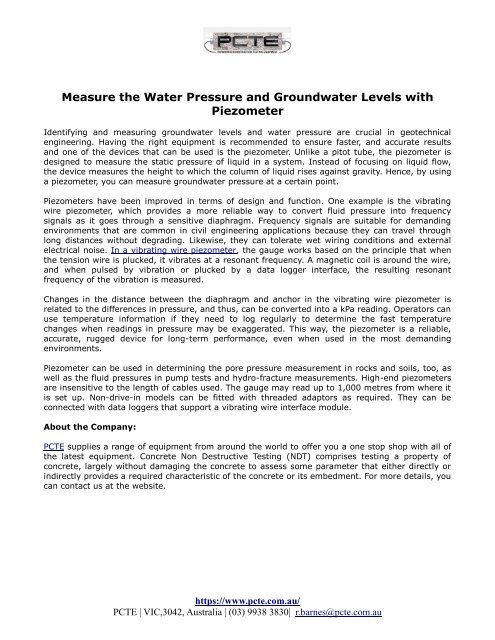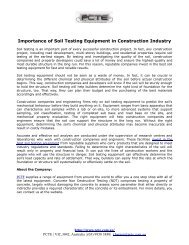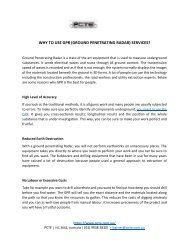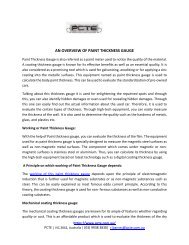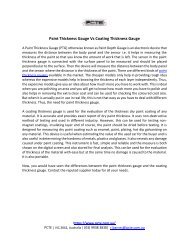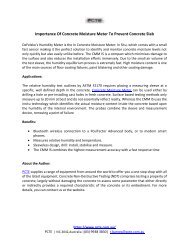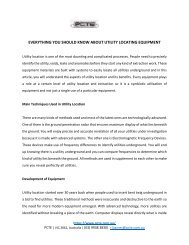Measure the Water Pressure and Groundwater Levels with Piezometer
Identifying and measuring groundwater levels and water pressure are crucial in geotechnical engineering.
Identifying and measuring groundwater levels and water pressure are crucial in geotechnical engineering.
You also want an ePaper? Increase the reach of your titles
YUMPU automatically turns print PDFs into web optimized ePapers that Google loves.
<strong>Measure</strong> <strong>the</strong> <strong>Water</strong> <strong>Pressure</strong> <strong>and</strong> <strong>Groundwater</strong> <strong>Levels</strong> <strong>with</strong><br />
<strong>Piezometer</strong><br />
Identifying <strong>and</strong> measuring groundwater levels <strong>and</strong> water pressure are crucial in geotechnical<br />
engineering. Having <strong>the</strong> right equipment is recommended to ensure faster, <strong>and</strong> accurate results<br />
<strong>and</strong> one of <strong>the</strong> devices that can be used is <strong>the</strong> piezometer. Unlike a pitot tube, <strong>the</strong> piezometer is<br />
designed to measure <strong>the</strong> static pressure of liquid in a system. Instead of focusing on liquid flow,<br />
<strong>the</strong> device measures <strong>the</strong> height to which <strong>the</strong> column of liquid rises against gravity. Hence, by using<br />
a piezometer, you can measure groundwater pressure at a certain point.<br />
<strong>Piezometer</strong>s have been improved in terms of design <strong>and</strong> function. One example is <strong>the</strong> vibrating<br />
wire piezometer, which provides a more reliable way to convert fluid pressure into frequency<br />
signals as it goes through a sensitive diaphragm. Frequency signals are suitable for dem<strong>and</strong>ing<br />
environments that are common in civil engineering applications because <strong>the</strong>y can travel through<br />
long distances <strong>with</strong>out degrading. Likewise, <strong>the</strong>y can tolerate wet wiring conditions <strong>and</strong> external<br />
electrical noise. In a vibrating wire piezometer, <strong>the</strong> gauge works based on <strong>the</strong> principle that when<br />
<strong>the</strong> tension wire is plucked, it vibrates at a resonant frequency. A magnetic coil is around <strong>the</strong> wire,<br />
<strong>and</strong> when pulsed by vibration or plucked by a data logger interface, <strong>the</strong> resulting resonant<br />
frequency of <strong>the</strong> vibration is measured.<br />
Changes in <strong>the</strong> distance between <strong>the</strong> diaphragm <strong>and</strong> anchor in <strong>the</strong> vibrating wire piezometer is<br />
related to <strong>the</strong> differences in pressure, <strong>and</strong> thus, can be converted into a kPa reading. Operators can<br />
use temperature information if <strong>the</strong>y need to log regularly to determine <strong>the</strong> fast temperature<br />
changes when readings in pressure may be exaggerated. This way, <strong>the</strong> piezometer is a reliable,<br />
accurate, rugged device for long-term performance, even when used in <strong>the</strong> most dem<strong>and</strong>ing<br />
environments.<br />
<strong>Piezometer</strong> can be used in determining <strong>the</strong> pore pressure measurement in rocks <strong>and</strong> soils, too, as<br />
well as <strong>the</strong> fluid pressures in pump tests <strong>and</strong> hydro-fracture measurements. High-end piezometers<br />
are insensitive to <strong>the</strong> length of cables used. The gauge may read up to 1,000 metres from where it<br />
is set up. Non-drive-in models can be fitted <strong>with</strong> threaded adaptors as required. They can be<br />
connected <strong>with</strong> data loggers that support a vibrating wire interface module.<br />
About <strong>the</strong> Company:<br />
PCTE supplies a range of equipment from around <strong>the</strong> world to offer you a one stop shop <strong>with</strong> all of<br />
<strong>the</strong> latest equipment. Concrete Non Destructive Testing (NDT) comprises testing a property of<br />
concrete, largely <strong>with</strong>out damaging <strong>the</strong> concrete to assess some parameter that ei<strong>the</strong>r directly or<br />
indirectly provides a required characteristic of <strong>the</strong> concrete or its embedment. For more details, you<br />
can contact us at <strong>the</strong> website.<br />
https://www.pcte.com.au/<br />
PCTE | VIC,3042, Australia | (03) 9938 3830| r.barnes@pcte.com.au


